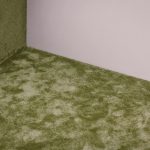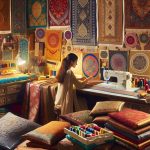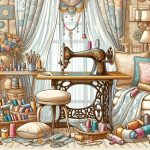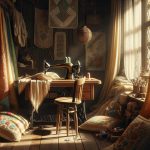Mastering intricate embroidery, crafting custom draperies, and creating tailored slipcovers can greatly enhance your home decor projects. You don't just add beauty and functionality; you also showcase your attention to detail and skill. Imagine the satisfaction of seeing your living space adorned with personalized designs and professional finishes like French pleats and mitered corners. But how do you achieve that level of craftsmanship? Let's explore some advanced sewing techniques that can transform your home decor from ordinary to extraordinary.
Table of Contents
Key Takeaways
- Utilize delicate French knots and satin stitches to add sophistication to home decor embroidery.
- Ensure accurate measuring and fabric selection for custom draperies to achieve a professional finish.
- Create tailored slipcovers with durable fabrics and high-quality thread for a snug, long-lasting fit.
- Experiment with mixing patterns and textures in decorative pillows to enhance room aesthetics.
- Employ professional finishes like French pleats and hand-sewn hems for a polished, refined look.
Intricate Embroidery
Delving into intricate embroidery, you'll discover a world of detailed patterns and techniques that elevate any sewing project. Mastering the French knots can add tiny, precise details to your work, transforming basic designs into sophisticated pieces. These knots are perfect for creating textured effects, whether you're working on floral motifs or abstract patterns.
Equally important is the satin stitch, which allows you to fill spaces with smooth, shiny threads, giving your embroidery a polished and professional look. Practice this stitch to achieve consistent coverage and depth, essential for high-quality finishes.
Exploring applique designs can open new creative possibilities. By attaching fabric pieces onto a larger background, you can craft dynamic, multi-layered visuals. Applique is ideal for adding bold shapes and vibrant colors to your projects, making them stand out.
Additionally, cross stitch patterns offer a structured approach to embroidery, with their grid-based designs ensuring precision and symmetry. By mastering cross stitch, you can create intricate images and complex designs that are both durable and visually stunning.
With these techniques, you'll not only enhance your sewing skills but also produce exquisite embroidered pieces that showcase your dedication to the craft.
Custom Draperies
After mastering intricate embroidery, you can turn your attention to creating custom draperies that add elegance and function to any room. Start by focusing on meticulous fabric selection; choose materials that complement your room's decor while considering the drapery's purpose.
Heavier fabrics like velvet or brocade work well for insulation and privacy, while lighter fabrics such as linen or sheer cotton are perfect for a breezy, open feel.
Accurate measuring is essential for a professional finish. Measure your windows precisely, taking into account the desired length and fullness of the drapery. Remember to add extra inches for hems and pleats. Consistency in measurements ensures your drapes hang perfectly.
When it comes to installation, your hardware choices play a significant role. Select rods, brackets, and finials that not only match your aesthetic but also support the weight of your fabric.
For heavier fabrics, choose sturdy, durable rods. Installation tips include using a level to make sure your rods are straight and mounting brackets securely into wall studs for maximum support.
Tailored Slipcovers
Creating custom slipcovers allows you to refresh your furniture's appearance while safeguarding it from wear and tear. Achieving professional results involves mastering the nuances of slipcover patterns and making informed fabric selections.
Begin by selecting a pattern that fits your furniture's dimensions and style. This step is vital to achieving a snug, custom appearance.
When choosing fabrics, consider durability, texture, and ease of maintenance. Opt for fabrics that complement your room's existing decor while offering longevity and comfort.
Here are some tips to help you excel in creating custom slipcovers:
- Measure accurately: Precise measurements ensure a perfect fit.
- Select the right fabric: Heavy-duty fabrics like canvas or denim are excellent for durability.
- Cut with precision: Follow the slipcover patterns meticulously to avoid errors.
- Use high-quality thread: Strong, matching thread enhances the slipcover's longevity and appearance.
- Complete edges: Employ techniques like serging or hemming to prevent fraying.
Decorative Pillows
Decorative pillows can instantly enhance the style and comfort of any space with their versatile designs and textures. To master this art, begin by selecting a color palette that complements your room. Whether you prefer bold contrasts or subtle shades, the right color choices can make a significant impact.
Next, focus on fabric choices. Luxurious velvets, crisp linens, or durable cottons each bring their unique touch to your decor. Experiment with mixing patterns and textures to create visual interest and depth. Don't shy away from intricate designs like embroidery or applique to add a personalized touch.
When it comes to pillow inserts, consider the stuffing options that best suit your needs. Feather and down inserts offer a plush, comfortable feel, while synthetic fillings provide firm support and are hypoallergenic. Make sure that your pillow inserts are slightly larger than the pillow covers to achieve a full, inviting look.
Professional Finishes
To achieve professional finishes in your sewing projects, pay close attention to the details that make your work look polished and refined. Mastering techniques like French pleats and hand sewn hems can elevate your home decor creations from amateur to artisan. These meticulous methods require precision but deliver impeccable results.
Here are five essential techniques for professional finishes:
- French pleats: These elegant folds add sophistication and structure to curtains and drapes, creating a tailored look that's hard to beat.
- Hand sewn hems: Unlike machine-stitched hems, hand sewing gives you complete control over each stitch, resulting in a cleaner, almost invisible seam.
- Mitered corners: Perfect for napkins, tablecloths, and quilts, mitered corners provide a sharp, professional edge that enhances the overall appearance.
- Bound edges: Using bias tape or fabric strips to bind edges not only conceals raw edges but also adds a decorative touch that's both functional and beautiful.
- Topstitching: This technique isn't just practical; it adds a decorative element and reinforces seams, ensuring they're both strong and stylish.
Frequently Asked Questions
How Do I Choose the Right Sewing Machine for Advanced Home Decor Projects?
Why settle for less? Choose a sewing machine based on essential features and your budget. Compare top sewing machine brands, read reviews, and guarantee it meets your advanced needs. Mastery requires the perfect tool.
What Are the Best Fabrics for Durable and Stylish Home Decor Items?
For durable and stylish home decor items, choose fabrics like heavyweight cotton, linen, or polyester blends. These home decor fabrics offer excellent longevity and maintain their fabric durability and style over time, ensuring lasting elegance.
Can Advanced Sewing Techniques Be Used for Outdoor Furniture?
Did you know 70% of outdoor cushions use advanced sewing techniques? You can create durable, stylish pieces with weather-resistant materials, ensuring your outdoor furniture withstands the elements while showcasing your mastery in sewing.
How Do I Maintain and Clean My Sewing Tools and Equipment?
To maintain and clean your sewing tools, ensure appropriate upkeep by storing supplies in a dry, organized space. Use specific cleaning techniques, like oiling scissors and brushes for dust removal, to ensure tool longevity and best performance.
What Are Some Common Mistakes to Avoid in Advanced Sewing for Home Decor?
To avoid common mistakes, focus on stitch quality and seam finishing. Guarantee accurate pattern alignment and make thoughtful fabric choices. These elements are essential for achieving professional results and mastering advanced sewing techniques.
- Does Chiffon Fabric Stink - July 15, 2025
- Does Chiffon Fabric Affect the Economy - July 15, 2025
- Does Cotton Fabric Have a Nap - July 15, 2025







